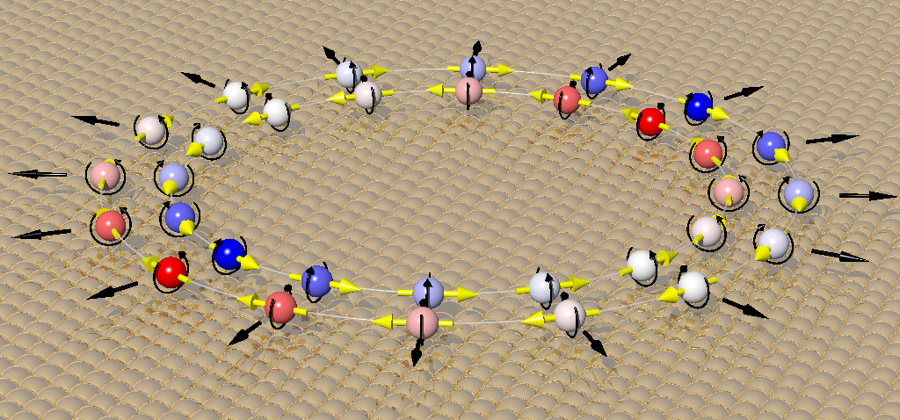Summary:
Researchers at the Institute for Molecular Science (IMS) have definitively resolved a two-decade-long controversy regarding the direction of electron spin on the surface of gold. Using a state-of-the-art Photoelectron Momentum Microscope (PMM) at the UVSOR synchrotron facility, the team captured complete two-dimensional snapshots of the Au(111) Shockley surface state, mapping both the electron's spin (its intrinsic magnetic property) and its orbital shape in a projection-based measurement. The experiment unambiguously confirmed the Rashba effect--where an electron's motion is coupled to its spin--by assigning a clockwise (cw) spin texture to the outer electron band and a counter-clockwise (ccw) texture to the inner band when viewed from the vacuum side. This work establishes a robust, trustworthy reference dataset for spin-resolved photoemission, paving the way for the development of highly efficient spintronic devices.
On the surface of noble metals like gold, a layer of electrons is confined to the topmost atomic layers, forming a quantum state known as the "Shockley surface state". Because the surface breaks the crystal's symmetry, a strong electric field is created perpendicular to the surface. This electric field causes the Rashba effect, which locks the electron's spin direction perpendicular to its direction of motion and splits the electronic state into two distinct rings of electrons with opposite in-plane spin directions. Due to differing experimental setups, coordinate systems, and analysis conventions, previous reports in the literature had produced two contradictory assignments for which ring spins clockwise (cw) and which spins counter-clockwise (ccw). The IMS team sought to settle this foundational question using a refined, high-efficiency imaging technique that overcomes these prior ambiguities.
The experiments utilized a twin-hemispherical-analyzer PMM at the UVSOR synchrotron facility, a unique apparatus capable of simultaneously capturing a wide, two-dimensional map of electron momentum and energy. To detect the spin, the microscope features a Spin Rotator placed before a 2D Spin Filter (an Ir(001) crystal). The Spin Rotator is essential, as it allows two images with opposite spin sensitivity to be acquired without moving the sample, enabling fast, sign-calibrated mapping. Crucially, to confirm the accurate detection of electron spin polarization and its sign, the system's calibration was validated using a ferromagnetic Ni(110) reference sample, guaranteeing the spin signal detected truly corresponds to the absolute physical direction (majority/up or minority/down).
The wide-field difference images, which highlight the contrast between electrons with opposite spins, unambiguously confirmed the long-disputed spin assignment: the outer electron band rotates clockwise (cw) and the inner band rotates counter-clockwise (ccw) when viewed from the vacuum side. Furthermore, by illuminating the surface with s-polarized VUV light at normal incidence, the team identified the dominant 6s and 6p atomic orbitals that constitute the surface state. This orbital identification was validated by the confirmation of an orbital selection rule: the photoelectron intensity dropped to zero for electrons emitted perpendicular to the light's electric-field vector. This finding directly demonstrates experimentally how the electron's specific orbital shape (its quantum symmetry) dictates how it interacts with the light's polarization, proving the fundamental electronic property of the surface state.
By providing a definitive, image-based assignment of both spin and orbital textures, this work establishes a trustworthy quantum reference for future materials science research. The refined PMM methodology allows for the fast, simultaneous, and sign-calibrated mapping of complete 2D spin and orbital textures. Specifically, the use of normal-incidence, polarization-controlled VUV light offers a new, simple and direct method for determining orbital character, helping researchers separate true electronic properties from experimental artifacts. Looking forward, this highly efficient approach can be extended to build a consistent "atlas" of spin textures across various materials and conditions, serving as a fundamental step for the design and development of spintronics, a future technology that aims to realize novel functional devices using exotic physical properties originating from electron spin.

Figure 1: The behavior of electrons on a single-crystal gold surface was investigated. On the Au(111) surface, a difference in the magnitude of the electrons' in-plane momentum component (proportional to the in-plane velocity) is observed, which depends on their spin orientation. The two opposite assignments for the orientation of the spin were left unresolved for 20 years. Ultimately, the spin orientation and the shape of the electron's orbit were determined by measuring the two-dimensional photoelectron momentum distribution. (Credit: Fumihiko Matsui, Restriction: News organizations may use or redistribute this image, with proper attribution, as part of news coverage of this paper only.)

Figure 2: A schematic diagram of the photoelectron momentum microscope at the UVSOR synchrotron facility, which utilizes two different synchrotron beams for the comprehensive spin and orbital analysis of material surfaces. (Credit: Fumihiko Matsui and Tomohiro Matsushita, Restriction: News organizations may use or redistribute this image, with proper attribution, as part of news coverage of this paper only.)

Figure 3: The electron state localized on the Au(111) surface was analyzed. Its spin orientation was determined using soft X-rays combined with a two-dimensional spin detector. By employing vacuum ultraviolet light in a normal-incidence setup, we can also clarify the characteristics of the atomic orbitals that shape this electronic state. (Credit: Fumihiko Matsui, Restriction: News organizations may use or redistribute this image, with proper attribution, as part of news coverage of this paper only.)
Information of the paper:
Authors: Fumihiko Matsui, Kenta Hagiwara, Yusuke Sato, Ryunosuke Sagehashi, Shigemasa Suga
Journal Name: Journal of the Physical Society of Japan (JPSJ)
Journal Title: "Spin and Orbital Polarizations of Au(111) Surface State Determined by Photoelectron Momentum Microscope"
DOI: 10.7566/JPSJ.94.114707
Financial Supports:
UVSOR Synchrotron Facility (BL6U and BL7U), Institute for Molecular Science -- Cooperative Research (IMS Program 22IMS1218 and 23IMS1216)
Contact Person:
Name: Fumihiko Matsui
TEL: +81-564-55-7201
E-mail: matui_at_ims.ac.jp (Please replace the "_at_" with @)
5329



